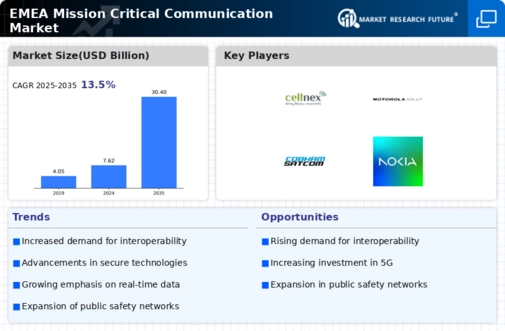Rising Cybersecurity Concerns
The Global EMEA Mission Critical Communication Market Industry faces increasing challenges related to cybersecurity. As communication systems become more interconnected, the risk of cyber threats escalates, potentially compromising critical operations. Organizations are prioritizing the implementation of robust cybersecurity measures to protect sensitive data and ensure the integrity of communication networks. This heightened focus on cybersecurity is driving investments in advanced security solutions, which are essential for maintaining trust in mission-critical communication systems. As the market evolves, addressing these cybersecurity concerns will be crucial for sustaining growth and ensuring the reliability of communication infrastructures.
Growing Focus on Interoperability
Interoperability among various communication systems is increasingly recognized as a vital component of the Global EMEA Mission Critical Communication Market Industry. As different agencies and organizations utilize diverse communication platforms, the ability to share information seamlessly becomes paramount. Efforts to standardize communication protocols are underway, facilitating better coordination during emergencies. For example, initiatives aimed at creating unified communication frameworks are being implemented across various regions. This focus on interoperability not only enhances operational efficiency but also improves response times in critical situations. The ongoing developments in this area are likely to bolster market growth and enhance the effectiveness of emergency responses.
Government Initiatives and Funding
Government initiatives play a crucial role in shaping the Global EMEA Mission Critical Communication Market Industry. Various governments are investing in modernizing communication infrastructures to ensure public safety and security. For example, the European Union has launched several funding programs aimed at enhancing emergency communication systems across member states. These initiatives not only provide financial support but also promote collaboration among different agencies. As a result, the market is likely to witness significant growth, with expectations of reaching 30.4 USD Billion by 2035. Such investments reflect a commitment to improving the resilience of communication networks in critical situations.
Technological Advancements in Communication
Technological advancements are pivotal in driving the Global EMEA Mission Critical Communication Market Industry. Innovations such as artificial intelligence, machine learning, and the Internet of Things are transforming how communication systems operate. These technologies enable more efficient data processing and analysis, leading to quicker decision-making in critical scenarios. For instance, AI-driven analytics can predict potential emergencies, allowing for proactive measures. The integration of these technologies is anticipated to enhance the capabilities of mission-critical communication systems, thereby attracting investments and fostering market growth. The compound annual growth rate of 13.41% from 2025 to 2035 indicates a robust trajectory for the industry.
Increasing Demand for Reliable Communication Systems
The Global EMEA Mission Critical Communication Market Industry experiences a rising demand for reliable communication systems, particularly in sectors such as public safety and emergency services. As urbanization accelerates, cities are increasingly adopting advanced communication technologies to enhance their emergency response capabilities. For instance, the integration of LTE and 5G networks is becoming prevalent, allowing for real-time data sharing among first responders. This trend is expected to contribute to the market's growth, with projections indicating a market value of 7.62 USD Billion in 2024. The need for uninterrupted communication during emergencies underscores the importance of robust systems in this sector.















Leave a Comment